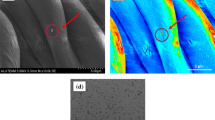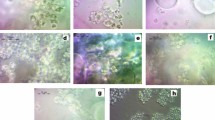Abstract
Liquid marble (LM), a non-stick drop coated with micro- or nano-scale particles, has great potential in a wide range of applications. LMs have an advantageous feature in which gas or vapor can freely transport through their particle shell; therefore, it makes them an ideal candidate to be utilized as microbioreactor containing aerobic microorganisms. In this study, safer and more biocompatible LMs were successfully prepared using a food-grade calcium stearate microparticle as a stabilizer. As the volume of core liquid increased, the height of LM increased and reached a constant value, as a similar trend has been reported in conventional LMs. The drying rate curve of the LMs confirmed that the LMs have a similar pattern with the drying of typical wet powders. The drying rate depended on the salt species in the core solution and the environmental humidity. For instance, in the case of MgCl2, by changing humidity from 40 to 80% RH, the lifetime of LMs (time in which the LM dried completely) was increased to about 900 min. This is nearly three times longer than those have no salt and at 40% RH. Model aerobic bacteria Bacillus subtilis has actively proliferated inside the LM during 24-h incubation. Comparing with the test tube cultivations under O2-rich stationary or O2 rich–shaken conditions, the cultivation in the LM system showed a higher proliferation than the test tube systems. As a conclusion, we demonstrated that the calcium stearate LM system would be an ideal candidate for safer and easily available microbioreactor containing aerobic bacteria.







Similar content being viewed by others
References
Aussillous, P., & Quéré, D. (2001). Liquid marbles. Nature, 411, 924–927.
Tian, J., Arbatan, T., Li, X., & Shen, W. (2010). Porous liquid marble shell offers possibilities for gas detection and gas reactions. Chemical Engineering Journal, 165, 347–353.
Arbatan, T., Li, L., Tian, J., & Shen, W. (2012). Liquid marbles as micro-bioreactors for rapid blood typing. Advanced Healthcare Materials, 1(1), 80–83.
Vadivelu, R. K., Kamble, H., Munaz, A., & Nguyen, N. (2017). Liquid marble as bioreactor for engineering three-dimensional toroid tissues. Scientific Reports, 7, 1–14.
Rychecký, O., Majerská, M., Král, V., Štěpánek, F., & Čejková, J. (2017). Spheroid cultivation of HT-29 carcinoma cell line in liquid marbles. Chemical Papers, 71, 1055–1063.
Sreejith, K. R., Gorgannezhad, L., Jin, J., Ooi, C. H., Stratton, H., Daoa, D. V., & Nguyen, N. (2019). Liquid marbles as biochemical reactors for the polymerase chain reaction. Lab on a Chip, 19, 3143–3356.
Huang, G., Li, M., Yang, Q., Li, Y., Liu, H., Yang, H., & Xu, F. (2017). Magnetically actuated droplet manipulation and its potential biomedical applications. ACS Applied Materials and Interfaces, 9(2), 1155–1166.
Luo, X., Yin, H., Li, X., Su, X., & Feng, Y. (2018). CO2-triggered microreactions in liquid marbles. Chemical Communications, 54, 9119–9122.
Tian, J., Fu, N., Chen, X., D, & Shen, W. (2013). Respirable liquid marble for the cultivation of microorganisms. Colloids and Surfaces B: Biointerfaces, 106, 187–190.
Chen, Z., Zang, D., Zhao, L., Qu, M., Li, X., Li, X., Li, L., & Geng, X. (2017). Liquid marble coalescence and triggered microreaction driven by acoustic levitation. Langmuir, 33(25), 6232–6239.
Gao, L., McCarthy, T., & J. (2007). Ionic liquid marbles. Langmuir, 23(21), 10445–10447.
Bormashenko, E., Pogreb, R., Whyman, G., Musin, A., & Bormashenko, Y. (2009). Shape, vibrations, and effective surface tension of water marbles. Langmuir, 25(4), 1893–1896.
Fullarton, C., Draper, T. C., Phillips, N., de Lacy Costello, B. P. J., & Adamatzky, A. (2019). Belousov–Zhabotinsky reaction in liquid marbles. J. Phys.: Mater., 2, 015005.
Doganci, M. D., Sesli, B. U., Erbil, H. Y., Binks, B. P., & Salama, I. E. (2011). Liquid marbles stabilized by graphite particles from aqueous surfactant solutions. Colloids and Surfaces A: Physicochemical and Engineering Aspects, 384, 417–426.
Rao, A. V., Kulkarni, M. M., & Bhagat, S. D. (2004). Transport of liquids using superhydrophobic aerogels. Journal of Colloid and Interface Science, 285, 413–418.
Li, X., Wang, Y., Huang, J., Yang, Y., Wang, R., Geng, X., & Zang, D. (2017). Monolayer nanoparticle-covered liquid marbles derived from a sol-gel coating. Applied Physics Letters, 111, 261604.
Li, X., Wang, R., Shi, H., & Song, B. (2018). Effective surface tension of liquid marbles using controllable nanoparticle monolayers. Applied Physics Letters, 113, 101602.
Li, X. (2019). Liquid marbles and liquid plasticines with nanoparticle monolayers. Advances in Colloid and Interface Science, 271, 101988–101997.
Geyer, F., Asaumi, Y., Vollmer, D., Butt, H.-J., Nakamura, Y., & Fujii, S. (2019). Polyhedral liquid marbles. Advanced Functional Materials, 29, 1808826.
Ihara, T., & Iriyama, Y. (2011). Characteristics of liquid marbles formed with plasma-treated hydrophobic cellulose powder. Photopolymer Science and Technology, 24, 435–440.
Hashmi, A., Strauss, A., & Xu, J. (2012). Freezing of a liquid marble. Langmuir, 28(28), 10324–10328.
Bormashenko, E., Pogreb, R., Musin, A., Balter, R., Whyman, G., & Aurbach, D. (2010). Interfacial and conductive properties of liquid marbles coated with carbon black. Powder Technology, 203, 529–533.
FDA, Substances Added to Food inventory (2018) https://www.accessdata.fda.gov/scripts/fdcc/?set=FoodSubstances. Accessed 28 Nov 2019.
Zang, D., Chen, Z., Zhang, Y., Lin, K., Genga, X., & Binks, B. P. (2013). Effect of particle hydrophobicity on the properties of liquid water marbles. Soft Matter, 9, 5067–5073.
Bormashenko, E., Pogreb, R., Whyman, G., & Musin, A. (2009). Surface tension of liquid marbles. Colloids Surf. A: Physicochem. Eng. Aspects, 351, 78–82.
Li, X., Shi, H., Wang, Y., Wang, R., Huang, S., Huang, J., Geng, X., & Zang, D. (2018). Liquid shaping based on liquid pancakes. Advanced Materials Interfaces, 5, 1701139.
Li, X., Wang, R., Huang, S., Wang, Y., & Shi, H. (2018). A capillary rise method for studying the effective surface tension of monolayer nanoparticle-covered liquid marbles. Soft Matter, 14, 9877–9884.
Dandan, M., & Erbil, H. Y. (2009). Evaporation rate of graphite liquid marbles: Comparison with water droplets. Langmuir, 25(14), 8362–8367.
Tosun, A., & Erbil, H. Y. (2009). Evaporation rate of PTFE liquid marbles. Applied Surface Science, 256, 1278–1283.
Berk, Z. (2013). Food process engineering and technology (2nd ed.pp. 464–472). Cambridge, MA: Academic Press.
Lee, M. T. (1996) On the mechanism of evaporation of water from a nonhygroscopic porous medium, Int. Comm. Heat and Mass Transfer, 23, 939–946.
Potter II, R. W., & Clynne, M. A. (1979). Solubility of some alkali and alkaline earth chlorides in water at moderate temperatures. Journal of Chemical & Engineering Data, 24, 338–340.
International Union of Pure and Applied Chemistry. (1991). Solubility data series (Vol. 47). Oxford: Pergamon Press.
Clapp, K. P., Castan, A., & Lindskog, E. K. (2018). Biopharmaceutical processing: Development, design, and implementation of manufacturing processes (pp. 457–476). Amsterdam: Elsevier.
Funding
This research was supported by the JSPS KAKENHI Grant Number JP18K04830.
Author information
Authors and Affiliations
Corresponding author
Ethics declarations
Conflict of Interest
The authors declare that they have no conflict of interest.
Additional information
Publisher’s Note
Springer Nature remains neutral with regard to jurisdictional claims in published maps and institutional affiliations.
Electronic Supplementary Material
ESM 1
(DOCX 2580 kb)
Rights and permissions
About this article
Cite this article
Tanaka, S., Okano, H., Matsuda, N. et al. Preparation of Biocompatible Liquid Marbles Stabilized by Food-Grade Stearate Microparticle for Aerobic Bacteria Cultivation. Appl Biochem Biotechnol 191, 1684–1694 (2020). https://doi.org/10.1007/s12010-020-03299-6
Received:
Accepted:
Published:
Issue Date:
DOI: https://doi.org/10.1007/s12010-020-03299-6




